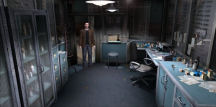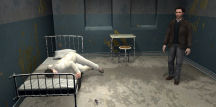As gamers, we are sometimes drawn to adventures that
contain intricate puzzles, or we anticipate upcoming adventures because of
their eye-catching graphics or beloved familiar characters from various
series. Equally engaging are the type of adventures whose chief
fascination lies in the stories that they tell -- how the plot elements
are woven together, revealed and, most importantly, how completely they
pull the gamer into the game’s universe.
Overclocked is one such adventure. House of
Tales (the German-based developers who brought us
Mystery of the Druids and
The Moment of Silence) has
come up with this new offering for the gaming community. It is ambitious,
exciting and yes, overclocked -- just as its name suggests -- in its look,
feel and attitude.
“Switched”
Overclocked is a
psychological thriller in which the gamer assumes the role of more than
one character, piecing together the mystery of what happened to five young
adults during a bleak and weatherworn November in Manhattan. The plot is
carefully interlaced between these five unfortunate souls and an
ex-military psychiatrist, David McNamara, who is overseeing their care. At
one time or another, the gamer will take on the persona of each of these
six main characters. Will McNamara be successful in delving into their
recent pasts? Can he help them mend the fragments of their shattered
minds? Will he be able to assist them without sacrificing his sanity,
giving up his own mind as forfeit?
The adventure is divided into various chapters -- each
with its own cryptic title -- which span the length of six days. The
chapter titles reflect the mood and disposition of McNamara as he relates
to both the storylines of the five patients and his own ghosts of the
past. How do they differ? How are they similar? Could the common thread
which connects all six characters be McNamara himself? The gamer (as
McNamara) will rebuild the “memories” of the five patients and how their
stories relate to one another. The techniques used include hypnosis and
“reverse memory tracking.” As the troubled young doctor delves deeper and
deeper into their psyches, the six plots begin to unfold. And as the
adventure drives inexorably to its conclusion, the underlying truth will
become all too terrifyingly clear.
“Delirium”
This is a third person point and click affair. The
inventory is always visible during game play. When an item is clicked on
from the inventory, the gamer has the ability to choose to either
“examine” or “use” the object in question. Within the inventory there is
an “electronic” inventory -- the PDA. Here one stores various phone
numbers. It is also possible to use the PDA to make phone calls, record
personal memos, receive emails and record each session with the five
patients under McNamara’s care. This is pivotal item for the good doctor
and is used constantly throughout the game.
Traversing the environments within the game is done with
a mouse click. Transparent arrows provide the directional movement from
area to area within a given screen; some of these can be difficult to see.
However, the exit icons from one screen to another are very clearly placed
at either the side or bottom of the various locations.
The puzzles and enigmas during the game are mostly
inventory based, although there are few number puzzles. None are difficult
as long as you follow the storyline and listen carefully to what is being
said. However, it is the “Triple P” or plot progression puzzles involving
the PDA which will allow the gamer to discover just who these six
characters truly are and the common thread to which they all desperately
cling.
While playing as David McNamara or the five patients,
the gamer cannot “die,” and there are no dead ends that could bring the
game to an abrupt conclusion. But this doesn’t mean that there is no
violence to be witnessed. There are a number of explicitly violent moments
within Overclocked, and
if you are of the squeamish sort where blood or death is concerned … you
have been warned.
“My Eyes
See”
The look and feel of the adventure is one of darkness
and oppression, mirroring the broken minds of the five young patients. The
constant use of storm, rain and night scenes accentuates the apprehensive
and uneasy atmosphere, as does the stark bleakness of the hospital. The
background artwork utilizes a dark though richly hued palette, combined
with animated aspects of weather, such as constant falling rain, storm
clouds and moving waters. Couple this with characters created by motion
capture within the cut scenes and we have indeed a captivatingly riveting
production.
The haunting and melancholy underscore rounds out this
ambiance. It heightens our senses and adds to our sinister forebodings as
we watch the story unfold. The clever use of split-screen also does much
to break the barrier of the fourth wall. It keeps the gamer on guard for
what may yet happen or for what may have happened that now must be relived
and pieced together.
The voice talent is clean and at times poignant – a
description that applies to each character, from Mr. McNamara down to the
bartender. These actors should all be commended on their work, as they
have created a strong sense of believability; they make it easy to care
and to fear for the characters that they portray.
“Overclock”
As Overclocked launches, the gamer is presented
with a small basic menu in which various parameters can be selected. These
are: Resume Game, Start New Game, Settings (which allow the gamer to
configure Language, Video and Audio parameters), Overclocked Home
Page, and House of Tales Forum.
The opening splash screens as well as cut scenes and/or
various blocks of dialogue may be skipped by pressing the ESC key twice.
Saving a game or loading another is accomplished in much the same way, as
long as the gamer is not within a dialogue tree at the time. Once the
dialogue has completed, using the ESC key twice will bring up the main
menu for either loading, saving or quitting the program. While there is no
“auto-save” function, one still may save at any time either by creating a
new save or by overwriting a previous saved game. Game saves are stored in
the “My Documents” folder.
There was one technical aspect of
Overclocked which I found to be
quite bizarre. Here we have two DVDs. DVD1 will load the game folder onto
the hard drive (at over 5GBs) and DVD2 must be in the drive to play the
game. Not an odd thing at first take; many games are set up this way. Yet,
given the recommended specifications of the parameters of the game and its
massive size, it seems odd to me that no option is given to load the 2GBs
of cut scene video into the game folder. This would have smoothed the
production, eliminating the unexpectedly long lag times that precede each
cut scene (while one waits for the DVD ROM to spin up to speed).
Because of the abrupt and often frustrating “black
screen of waiting for what is still to come,” my own immersion and
concentration during game play were seriously affected. However, I
suffered through these episodes for only the first two chapters of the
game, as I soon realized that all that needed to be done was to move the
resource.200 file into the game folder. Once this was accomplished,
I found that there were no more lag times between active game play and cut
scenes, thus allowing a more seamless transition between the two.
Particularly in a psychological thriller like this one, smooth transitions
are so important to game immersion and the willing suspension of disbelief
that it’s perplexing that the gamer has to manually move a file to
accomplish what should have been the work of the installation program.
“The
Soul of the Game”
Overclocked
is an ambitious endeavor, offering dozens of highly detailed locations,
many and various characters to interact with and a goodly amount of
interesting and expertly executed dialogue. I found the script very tight
and well written, for both the main plot as well as the good doctor’s
subplot. There are minimal “holes” as the main story progresses, although
I did feel that the subplot was somewhat predictable.
The game’s projected course of play is approximately
twenty hours. For me it was nearer to twenty-five and took me the better
part of a week to accomplish. The adventure itself I found to be very
linear, with logical clues coming one after the other within the dialogue
of various characters or from McNamara’s own inner monologues. The puzzles
are especially organic to the adventure and include inventory and number
sequence challenges, as well as in-depth “PDA recording” analysis. I found
the last type to be extremely entertaining and innovative, effectively
putting me into the position of the troubled and careworn psychiatrist …
examining, probing, and compiling the necessary data to formulate the
patients’ experiences and the horrific realization of whom they may
represent.
So, would I recommend this
game to my fellow players? The answer is yes I would, as long as the gamer
welcomes a thought-provoking experience that doesn’t shy away from
controversy, and understands the cut scene lag time and how to properly
deal with it.
Grade: B+
Minimum Requirements:
OS:
Windows 2000/ XP / Vista
Processor: 1.3 GHz
Processor
Video Card: DirectX
9 compliant video card with Shader Model 1.1
Free Hard Disk
Space: 1.5 GB
RAM: 256MB – Windows
2000/XP
RAM: 512MB – Windows
Vista
Sound Card: DirectX 9 Compliant
DVD ROM Drive
Keyboard & Mouse
Recommended Requirements:
OS:
Windows 2000/ XP / Vista
Processor: 2 GHz
Processor
Video Card: DirectX
9 compliant video card with Shader Model 2.0
Free Hard Disk
Space: 5.5 GB
RAM: 512MB – Windows
2000/XP
RAM: 1024MB –
Windows Vista
Sound Card: DirectX 9 Compliant
DVD ROM Drive
Keyboard & Mouse
Played on:
OS: Microsoft Windows XP Home
SP 2
CPU: Pentium D 950 3.4GHz
800MHz
RAM: 2GB DDR2
Video: BFG nVidia Geforce
7600GT OC 256MB 128bit
Sound: SoundBlaster Audigy
DVD ROM: DVD-ROM DVD-1S16P 16x
SONY DRU 820A DVD+RW/+R/RAM/cd
8.5GB 16x8x8x16x6x6x5x Dual Layer/Double Layer
Monitor: Northgate 20' Flat
Panel Monitor
DirectX Version: 9.0c
May 2008
design copyright ©
2008
GameBoomers
Group



